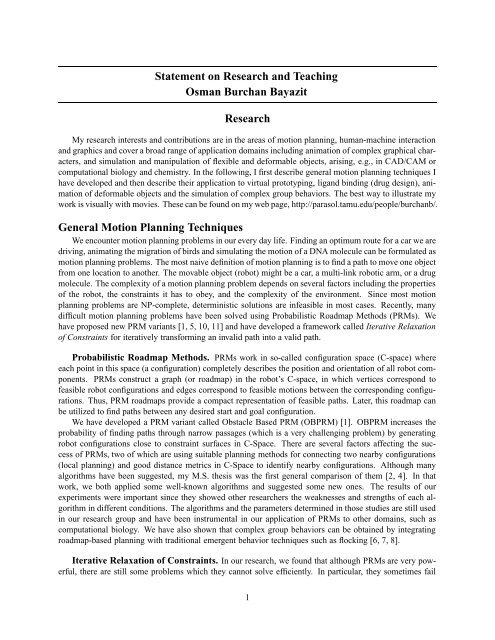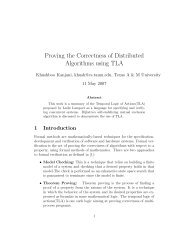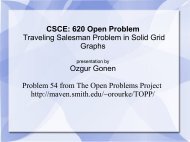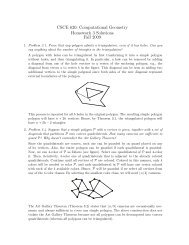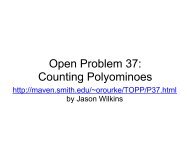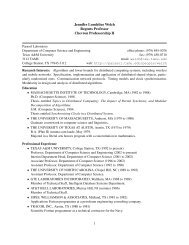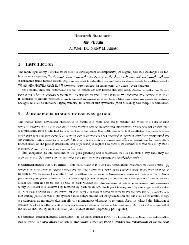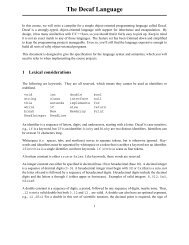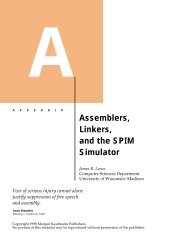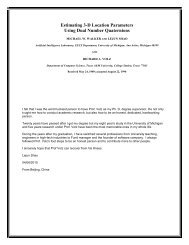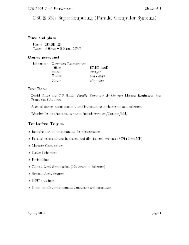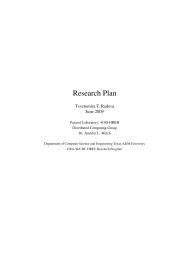Statement on Research and Teaching Osman Burchan Bayazit ...
Statement on Research and Teaching Osman Burchan Bayazit ...
Statement on Research and Teaching Osman Burchan Bayazit ...
Create successful ePaper yourself
Turn your PDF publications into a flip-book with our unique Google optimized e-Paper software.
<str<strong>on</strong>g>Statement</str<strong>on</strong>g> <strong>on</strong> <strong>Research</strong> <strong>and</strong> <strong>Teaching</strong><br />
<strong>Osman</strong> <strong>Burchan</strong> <strong>Bayazit</strong><br />
<strong>Research</strong><br />
My research interests <strong>and</strong> c<strong>on</strong>tributi<strong>on</strong>s are in the areas of moti<strong>on</strong> planning, human-machine interacti<strong>on</strong><br />
<strong>and</strong> graphics <strong>and</strong> cover a broad range of applicati<strong>on</strong> domains including animati<strong>on</strong> of complex graphical characters,<br />
<strong>and</strong> simulati<strong>on</strong> <strong>and</strong> manipulati<strong>on</strong> of flexible <strong>and</strong> deformable objects, arising, e.g., in CAD/CAM or<br />
computati<strong>on</strong>al biology <strong>and</strong> chemistry. In the following, I first describe general moti<strong>on</strong> planning techniques I<br />
have developed <strong>and</strong> then describe their applicati<strong>on</strong> to virtual prototyping, lig<strong>and</strong> binding (drug design), animati<strong>on</strong><br />
of deformable objects <strong>and</strong> the simulati<strong>on</strong> of complex group behaviors. The best way to illustrate my<br />
work is visually with movies. These can be found <strong>on</strong> my web page, http://parasol.tamu.edu/people/burchanb/.<br />
General Moti<strong>on</strong> Planning Techniques<br />
We encounter moti<strong>on</strong> planning problems in our every day life. Finding an optimum route for a car we are<br />
driving, animating the migrati<strong>on</strong> of birds <strong>and</strong> simulating the moti<strong>on</strong> of a DNA molecule can be formulated as<br />
moti<strong>on</strong> planning problems. The most naive definiti<strong>on</strong> of moti<strong>on</strong> planning is to find a path to move <strong>on</strong>e object<br />
from <strong>on</strong>e locati<strong>on</strong> to another. The movable object (robot) might be a car, a multi-link robotic arm, or a drug<br />
molecule. The complexity of a moti<strong>on</strong> planning problem depends <strong>on</strong> several factors including the properties<br />
of the robot, the c<strong>on</strong>straints it has to obey, <strong>and</strong> the complexity of the envir<strong>on</strong>ment. Since most moti<strong>on</strong><br />
planning problems are NP-complete, deterministic soluti<strong>on</strong>s are infeasible in most cases. Recently, many<br />
difficult moti<strong>on</strong> planning problems have been solved using Probabilistic Roadmap Methods (PRMs). We<br />
have proposed new PRM variants [1, 5, 10, 11] <strong>and</strong> have developed a framework called Iterative Relaxati<strong>on</strong><br />
of C<strong>on</strong>straints for iteratively transforming an invalid path into a valid path.<br />
Probabilistic Roadmap Methods. PRMs work in so-called c<strong>on</strong>figurati<strong>on</strong> space (C-space) where<br />
each point in this space (a c<strong>on</strong>figurati<strong>on</strong>) completely describes the positi<strong>on</strong> <strong>and</strong> orientati<strong>on</strong> of all robot comp<strong>on</strong>ents.<br />
PRMs c<strong>on</strong>struct a graph (or roadmap) in the robot’s C-space, in which vertices corresp<strong>on</strong>d to<br />
feasible robot c<strong>on</strong>figurati<strong>on</strong>s <strong>and</strong> edges corresp<strong>on</strong>d to feasible moti<strong>on</strong>s between the corresp<strong>on</strong>ding c<strong>on</strong>figurati<strong>on</strong>s.<br />
Thus, PRM roadmaps provide a compact representati<strong>on</strong> of feasible paths. Later, this roadmap can<br />
be utilized to find paths between any desired start <strong>and</strong> goal c<strong>on</strong>figurati<strong>on</strong>.<br />
We have developed a PRM variant called Obstacle Based PRM (OBPRM) [1]. OBPRM increases the<br />
probability of finding paths through narrow passages (which is a very challenging problem) by generating<br />
robot c<strong>on</strong>figurati<strong>on</strong>s close to c<strong>on</strong>straint surfaces in C-Space. There are several factors affecting the success<br />
of PRMs, two of which are using suitable planning methods for c<strong>on</strong>necting two nearby c<strong>on</strong>figurati<strong>on</strong>s<br />
(local planning) <strong>and</strong> good distance metrics in C-Space to identify nearby c<strong>on</strong>figurati<strong>on</strong>s. Although many<br />
algorithms have been suggested, my M.S. thesis was the first general comparis<strong>on</strong> of them [2, 4]. In that<br />
work, we both applied some well-known algorithms <strong>and</strong> suggested some new <strong>on</strong>es. The results of our<br />
experiments were important since they showed other researchers the weaknesses <strong>and</strong> strengths of each algorithm<br />
in different c<strong>on</strong>diti<strong>on</strong>s. The algorithms <strong>and</strong> the parameters determined in those studies are still used<br />
in our research group <strong>and</strong> have been instrumental in our applicati<strong>on</strong> of PRMs to other domains, such as<br />
computati<strong>on</strong>al biology. We have also shown that complex group behaviors can be obtained by integrating<br />
roadmap-based planning with traditi<strong>on</strong>al emergent behavior techniques such as flocking [6, 7, 8].<br />
Iterative Relaxati<strong>on</strong> of C<strong>on</strong>straints. In our research, we found that although PRMs are very powerful,<br />
there are still some problems which they cannot solve efficiently. In particular, they sometimes fail<br />
1
(a) (b) (c)<br />
Figure 1: (a) Elbow-hole, goal is to move elbow inside the hole in virtual prototyping. (b) A sample roadmap<br />
visualizati<strong>on</strong>. Big tube is an obstacle, small tubes are roadmap nodes showing positi<strong>on</strong> <strong>and</strong> orientati<strong>on</strong> informati<strong>on</strong> for<br />
a tube robot. (c) Haptic feedback in lig<strong>and</strong> binding.<br />
due to the difficulty of discovering ‘critical’ c<strong>on</strong>figurati<strong>on</strong>s of the ‘robot’ that are in tight, or crowded, regi<strong>on</strong>s<br />
but which are crucial c<strong>on</strong>figurati<strong>on</strong>s in the resulting path. To address this problem, we have developed<br />
techniques aimed at helping an automated planner c<strong>on</strong>centrate its explorati<strong>on</strong> <strong>on</strong> critical regi<strong>on</strong>s of C-space.<br />
In this approach, instead of directly solving the original problem, we first try to solve a relaxed (easier) problem.<br />
The planner uses the soluti<strong>on</strong> for the relaxed versi<strong>on</strong> to guide its search for a soluti<strong>on</strong> to the original<br />
problem. This approach can be applied iteratively, so that a soluti<strong>on</strong> to each relaxed versi<strong>on</strong> is used as a<br />
guide for solving the succeeding versi<strong>on</strong>.<br />
In fact, we have found this approach which we call Iterative Relaxati<strong>on</strong> of C<strong>on</strong>straints (IRC) to be so<br />
effective, it is the topic of my dissertati<strong>on</strong>. As described below, we have successfully applied IRC to several<br />
domains: virtual prototyping [3, 9, 10], lig<strong>and</strong> binding [11, 12], <strong>and</strong> deformable objects [5].<br />
Applicati<strong>on</strong>s<br />
The widespread applicability of moti<strong>on</strong> planning has provided me with the unique opportunity to apply<br />
my techniques to problems in many diverse domains, such as CAD/CAM, Graphics <strong>and</strong> Animati<strong>on</strong>, <strong>and</strong><br />
Computati<strong>on</strong>al Biology. This experience has helped me to develop the necessary skills to quickly move into<br />
new research areas. Below, I describe some of the applicati<strong>on</strong>s <strong>on</strong> which I have worked.<br />
Human-Computer Interacti<strong>on</strong>. As previously menti<strong>on</strong>ed, automated planners sometimes fail to<br />
solve problems in which the soluti<strong>on</strong> path is required to pass through narrow passages. In some such cases<br />
the general structure of the soluti<strong>on</strong> is naturally apparent to a human observer. IRC provides a natural<br />
paradigm to exploit such human intuiti<strong>on</strong> without requiring the human to generate the complete soluti<strong>on</strong>.<br />
We have investigated strategies for integrating human guidance <strong>and</strong> automated planning [3, 9, 10, 11, 12].<br />
Ours was first work which sought to combine automatic moti<strong>on</strong> planning with human input. We have<br />
implemented novel human-computer interacti<strong>on</strong> methods to facilitate collecti<strong>on</strong> of user input with a haptic<br />
device for virtual prototyping <strong>and</strong> lig<strong>and</strong> binding (drug design).<br />
Virtual Prototyping. We solved several problems using the IRC technique <strong>and</strong> human-computer interacti<strong>on</strong><br />
methods which were infeasible for traditi<strong>on</strong>al automated planners [3, 9, 10]. These problems were<br />
drawn from the domain of virtual prototyping, <strong>and</strong> in particular, design for maintainability studies. A design<br />
would have better maintainability if the parts are accessible from outside. Usually, the accessibility of particular<br />
parts is tested using physical mock-ups of the system. Our work, which treats the parts to be removed<br />
as robots <strong>and</strong> applies moti<strong>on</strong> planning techniques, could ultimately remove the need for physical mock-ups<br />
by enabling such tests to be performed virtually <strong>on</strong> three–dimensi<strong>on</strong>al CAD/CAM models (see Figure 1(a)).<br />
In our experiments we solved several problems which were infeasible for fully automated planners. Indeed,<br />
2
(a) (b) (c)<br />
Figure 2: (a) <strong>and</strong> (b) Two different deformati<strong>on</strong> methods for deformable objects, (c) deformable objects with flocking<br />
behavior.<br />
with a human operator’s guidance, our automated planner was able to find accessibility paths for parts in<br />
very c<strong>on</strong>fined situati<strong>on</strong>s such as in a mechanical design. To help the human operator’s percepti<strong>on</strong> of the<br />
envir<strong>on</strong>ment we used a haptic device (PHANToM) which let the user sense the virtual object as if the user<br />
were touching it. Almost all haptic interacti<strong>on</strong> applicati<strong>on</strong>s c<strong>on</strong>centrate <strong>on</strong> simple representati<strong>on</strong>s of virtual<br />
objects. One of our achievements in this research was to develop an algorithm to provide a realistic sense of<br />
touch for very complex 3D virtual object pairs. We also developed some simple visualizati<strong>on</strong> techniques to<br />
illustrate the planner’s progress (see Figure 1(b)). These techniques are still used in our group to underst<strong>and</strong><br />
the planner’s behavior <strong>and</strong> several other researchers have expressed their interest. Whether starting from<br />
user-generated or automatically generated paths, we showed that the IRC technique enabled faster soluti<strong>on</strong>.<br />
In our experiments, easier versi<strong>on</strong>s of the problem were generated by reducing the size of the robot. We<br />
found that IRC <strong>and</strong> human hints are complementary to each other <strong>and</strong> human computer interacti<strong>on</strong> can<br />
improve the performance of the planner.<br />
Bioinformatics (Lig<strong>and</strong> Binding). Moti<strong>on</strong> planning techniques inspired by PRMs have been successfully<br />
applied to biochemistry problems such as protein folding <strong>and</strong> lig<strong>and</strong> binding (also known as molecular<br />
docking used in drug design). Our work in lig<strong>and</strong> binding is <strong>on</strong>e of the early studies of this topic <strong>and</strong> we<br />
look forward to further developing this technique.<br />
In [11, 12], we applied the PRM moti<strong>on</strong> planning techniques to the lig<strong>and</strong> binding problem. In this case,<br />
the robot was a flexible drug molecule <strong>and</strong> the goal was to find a binding site in a given protein molecule. The<br />
problem is very high dimensi<strong>on</strong>al with c<strong>on</strong>straints imposed by energy related, geometrical <strong>and</strong> biochemical<br />
properties. In this research we successfully generated c<strong>on</strong>figurati<strong>on</strong>s within a few angstroms of the original<br />
site (which is c<strong>on</strong>sidered to be in the binding site). Unlike most known docking algorithms, our algorithm<br />
does not require a priori knowledge of the studied molecules. Similar to our work in virtual prototyping, we<br />
used a haptic device to generate user input. Using the haptic device, an operator felt the molecular forces<br />
applied <strong>on</strong> the drug molecule as it was moved around the protein <strong>and</strong> was able to suggest some binding sites.<br />
The haptic device also helped the user to underst<strong>and</strong> the molecular interacti<strong>on</strong>s <strong>and</strong> the binding process.<br />
There are few haptic applicati<strong>on</strong>s implemented for this challenging problem <strong>and</strong> even in its preliminary<br />
stage, our implementati<strong>on</strong> is promising. We have been collaborating with researchers from the Department<br />
of Biochemistry to improve our algorithms.<br />
Graphics <strong>and</strong> Animati<strong>on</strong>. Moti<strong>on</strong> of objects plays an important role in computer animati<strong>on</strong>. For<br />
example, the movement of an artificial character requires finding the individual joint angles for the body<br />
posture. Moti<strong>on</strong> planning is also an important part of several artificial life problems which require individual<br />
or group movements such as simulati<strong>on</strong> of a flock of birds, a school of fish, or ant movements. We have<br />
successfully applied moti<strong>on</strong> planning algorithms to such problems in our research.<br />
3
(a) (b) (c)<br />
Figure 3: (a) Exploring with roadmaps, white areas are the explored areas, (b) Passing through a narrow passage as a<br />
flock (c)Passing through a narrow passage with a FOLLOW-THE-LEADER strategy.<br />
Deformable Objects. There are some problems which require the object to deform. For example,<br />
finding a cutting path for a surgical blade would require the tissue <strong>and</strong> veins to deform based <strong>on</strong> the moti<strong>on</strong><br />
of the blade. The IRC paradigm can be applied to plan moti<strong>on</strong>s for deformable objects. In [5], we studied<br />
methods to find paths for a robot which is allowed to change its shape to avoid collisi<strong>on</strong> with obstacles. The<br />
moti<strong>on</strong> planning problem for deformable objects is hard since there are an infinite number of possibilities<br />
for the form of a deformable object <strong>and</strong> r<strong>and</strong>om sampling can cover <strong>on</strong>ly a very small fracti<strong>on</strong> of them. In<br />
our approach, we first found a path for a n<strong>on</strong>-deformable (rigid) versi<strong>on</strong> of the robot. This path may c<strong>on</strong>tain<br />
colliding c<strong>on</strong>figurati<strong>on</strong>s, i.e., we relaxed the collisi<strong>on</strong> free c<strong>on</strong>straint in IRC. Later, we deformed the robot<br />
to avoid collisi<strong>on</strong>. We have developed several strategies to generate the initial path which may involve small<br />
collisi<strong>on</strong>s. We have also developed two different techniques to deform the robot (see Figure 2). We believe<br />
our research in this area will pi<strong>on</strong>eer an advance in several areas including deformable robots, animati<strong>on</strong><br />
<strong>and</strong> simulati<strong>on</strong>.<br />
Simulating Group Behaviors. In recent work, I’m developing better group behaviors using rule-based<br />
roadmap methods. This work has applicati<strong>on</strong> in animati<strong>on</strong> <strong>and</strong> artificial life problems. In [8], we show<br />
that roadmaps can be used to implement better flocking behaviors in complex envir<strong>on</strong>ments than the current<br />
techniques. In particular we were able to simulate the following behaviors: (i) homing (where a flock tries<br />
to reach a goal whose locati<strong>on</strong> is known), (ii) goal searching (where a flock tries to locate a goal), (iii)<br />
covering (where a flock tries to visit every regi<strong>on</strong> of the envir<strong>on</strong>ment, see Figure 3(a)) <strong>and</strong> (iv) shepherding<br />
(where an external agent steers a flock towards the goal). The advantage of our roadmap-based approach<br />
over the traditi<strong>on</strong>al techniques is that a roadmap stores global informati<strong>on</strong> of the scene <strong>and</strong> can be used as a<br />
simple communicati<strong>on</strong> media between flock members. Later, we developed the c<strong>on</strong>cept of adding rules to<br />
the roadmap to distinguish different behaviors in different regi<strong>on</strong>s of the roadmap [6, 7]. In this work we<br />
show that character behavior can be influenced by rules encoded in the characters <strong>and</strong> the roadmaps. For<br />
example, if a basic homing behavior is used to pass through a narrow passage, the passage may become<br />
too crowded (Figure 3(b)), where as if we have a follow-the-leader behavior in the narrow passage, the<br />
flock members can leave some separati<strong>on</strong> between succeeding <strong>and</strong> preceding members (Figure 3(c)). Our<br />
approach to group behaviors has received interest from researchers in robotics [6], graphics [8] <strong>and</strong> artificial<br />
life [7]. We are currently c<strong>on</strong>sidering applying these techniques to mobile robots.<br />
Future work<br />
Probabilistic Roadmap Methods are very powerful techniques <strong>and</strong> their limits have yet to be discovered.<br />
In our research group, they are applied to several domains which were initially thought to be unrelated<br />
to moti<strong>on</strong> planning, such as protein folding, lig<strong>and</strong> binding, neur<strong>on</strong> c<strong>on</strong>structi<strong>on</strong>, etc. I plan to c<strong>on</strong>tinue<br />
4
my research <strong>on</strong> moti<strong>on</strong> planning, <strong>and</strong> I’m particularly interested in c<strong>on</strong>tinuing to explore the applicability of<br />
PRM-based techniques in bioinformatics. I plan to investigate how optimizati<strong>on</strong> techniques such as machine<br />
learning <strong>and</strong> genetic algorithms can be combined with PRMs. I believe that hybrid systems incorporating<br />
the strengths of these various methods will enable still more problems to be solved using moti<strong>on</strong> planning<br />
methods.<br />
<strong>Teaching</strong> <strong>and</strong> Mentoring<br />
I have always enjoyed teaching, <strong>and</strong> I look forward to this aspect of my academic career. I enjoy interacti<strong>on</strong>s<br />
with undergraduate <strong>and</strong> graduate students <strong>and</strong> have experience in both classroom teaching <strong>and</strong> research<br />
mentoring.<br />
<strong>Teaching</strong><br />
In Fall 2002, I’ve been given the opportunity to be the primary instructor for CPSC 311-502, the required<br />
Analysis of Algorithms course for Computer Science <strong>and</strong> Computer Engineering undergraduate majors at<br />
Texas A&M University. Instructing <strong>on</strong>e of the most fundamental <strong>and</strong> most feared courses in Computer<br />
Science challenges me to inspire <strong>and</strong> motivate the students <strong>and</strong> enables me to prepare myself for an academic<br />
career. I am enjoying learning techniques that enable me to engage the students in the class. I believe my<br />
dynamic teaching style <strong>and</strong> availability lets the students not <strong>on</strong>ly enjoy the class but encourages them to<br />
c<strong>on</strong>sider broader issues in Computer Science. This is emphasized by my use of “Computer Science Culture”<br />
assignments where the students are encouraged to attend several research seminars during the semester.<br />
My teaching experience is not limited to CPSC-311. Since my early graduate studies at Middle East<br />
Technical University (METU) in Turkey, I have been in c<strong>on</strong>tinuous interacti<strong>on</strong> with undergraduate students.<br />
During my assistantship at METU, I enjoyed being a lab instructor for the microprocessor class for which I<br />
designed several experiments. I was also a teaching assistant for a ’C’ programming course which required<br />
c<strong>on</strong>tinuous interacti<strong>on</strong> with the students not <strong>on</strong>ly during the lab hours but also during n<strong>on</strong>-office hours. Although<br />
in my later semesters I was <strong>on</strong>ly resp<strong>on</strong>sible for the Department of Computer Engineering’s students,<br />
in my first semester, I was fortunate enough to be a lab instructor for a university wide computer languages<br />
class (including Fortran, Pascal <strong>and</strong> C). For a military project which aimed to increase the number of computer<br />
scientists in the military, I was selected as a lab instructor <strong>and</strong> helped several officers with ranks from<br />
1st Lieutenant to Major learn ’C’ programming. I was also an organizer <strong>and</strong> instructor for several introductory<br />
computer classes offered by the METU Computer Club (for which I served as vice president) during<br />
my sophomore <strong>and</strong> junior years. Those classes were open to any student that lacked computer background.<br />
Such opportunities helped me underst<strong>and</strong> <strong>and</strong> teach students with diverse backgrounds.<br />
<strong>Research</strong> Mentoring<br />
Although my teaching experience gave me invaluable insights about teaching in an academic envir<strong>on</strong>ment,<br />
this is not the <strong>on</strong>ly way I have interacted with students. During my graduate study at Texas A&M<br />
University, I used my teaching experience in my interacti<strong>on</strong>s with several undergraduate students who were<br />
members of our research group. I was the primary supervisor <strong>and</strong> research mentor for several undergraduate<br />
research projects. As <strong>on</strong>e of the system administrators of our group, I was resp<strong>on</strong>sible for their acquaintance<br />
with the system. Since I was <strong>on</strong>e of the most senior students in our group (always, since my adviser was<br />
a new assistant professor), I was also teaching them the basic moti<strong>on</strong> planning algorithms as well as the<br />
internal structure of our algorithms <strong>and</strong> project code. On several occasi<strong>on</strong>s I suggested new technologies to<br />
them which helped them not <strong>on</strong>ly in our research projects but also in their own work. During my graduate<br />
study, I enjoyed my interacti<strong>on</strong> with undergraduate students <strong>and</strong> I look forward to c<strong>on</strong>tinuing this activity as<br />
a faculty member.<br />
5
<strong>Teaching</strong> Interests<br />
I have a wide range of teaching interests. I can teach any undergraduate class, any core graduate class <strong>and</strong><br />
specialty graduate courses in my areas of expertise. I look forward to giving back the knowledge I acquired<br />
through the years of my study, especially the topics related to robotics, machine learning, computer graphics,<br />
algorithms, data structures <strong>and</strong> programming languages.<br />
Finally, I would like to note that Middle East Technical University is <strong>on</strong>e of the top universities in Turkey<br />
<strong>and</strong> its students are a select few am<strong>on</strong>g from milli<strong>on</strong>s of c<strong>and</strong>idates entering nati<strong>on</strong>wide placement exam<br />
each year. This makes the students very dem<strong>and</strong>ing in all respects. I believe my experience there, as well as<br />
my interacti<strong>on</strong>s <strong>and</strong> teaching experience with the students at Texas A&M University, has left me prepared<br />
to teach at any undergraduate or graduate institute.<br />
References<br />
[1] N. M. Amato, O. B. <strong>Bayazit</strong>, L. K. Dale, C. V. J<strong>on</strong>es, <strong>and</strong> D. Vallejo. OBPRM: An obstacle-based PRM for 3D workspaces.<br />
In Proc. Int. Workshop <strong>on</strong> Algorithmic Foundati<strong>on</strong>s of Robotics (WAFR), pages 155–168, 1998.<br />
[2] N. M. Amato, O. B. <strong>Bayazit</strong>, L. K. Dale, C. V. J<strong>on</strong>es, <strong>and</strong> D. Vallejo. Choosing good distance metrics <strong>and</strong> local planners for<br />
probabilistic roadmap methods. IEEE Trans. Robot. Automat., 16(4):442–447, August 2000. Preliminary versi<strong>on</strong> appeared in<br />
ICRA 1998, pp. 630–637.<br />
[3] N. M. Amato, O. B. <strong>Bayazit</strong>, <strong>and</strong> G. S<strong>on</strong>g. Providing haptic ‘hints’ to automatic moti<strong>on</strong> planners. In Proceedings of the<br />
Phantom User’s Group Workshop, Oct 1999.<br />
[4] O. B. <strong>Bayazit</strong>. Choosing good distance metrics <strong>and</strong> local planners for probabilistic roadmap methods. Master’s thesis, Texas<br />
A&M University, May 1998.<br />
[5] O. B. <strong>Bayazit</strong>, J.-M. Lien, <strong>and</strong> N. M. Amato. Probabilistic roadmap moti<strong>on</strong> planning for deformable objects. In Proc. IEEE<br />
Int. C<strong>on</strong>f. Robot. Autom. (ICRA), pages 2126–2133, 2002.<br />
[6] O. B. <strong>Bayazit</strong>, J.-M. Lien, <strong>and</strong> Nancy M. Amato. Better flocking behaviors using rule-based roadmaps. In Proc. Int. Workshop<br />
<strong>on</strong> Algorithmic Foundati<strong>on</strong>s of Robotics (WAFR), Dec 2002. To appear.<br />
[7] O. B. <strong>Bayazit</strong>, J.-M. Lien, <strong>and</strong> Nancy M. Amato. Better group behaviors in complex envir<strong>on</strong>ments using global roadmaps. In<br />
Artif. Life, Dec 2002. To appear.<br />
[8] O. B. <strong>Bayazit</strong>, J.-M. Lien, <strong>and</strong> Nancy M. Amato. Roadmap-based flocking for complex envir<strong>on</strong>ments. In Proc. Pacific<br />
Graphics, pages 104–113, Oct 2002.<br />
[9] O. B. <strong>Bayazit</strong>, G. S<strong>on</strong>g, <strong>and</strong> N. M. Amato. Enhancing r<strong>and</strong>omized moti<strong>on</strong> planners: Exploring with haptic hints. In Proc.<br />
IEEE Int. C<strong>on</strong>f. Robot. Autom. (ICRA), pages 529–536, 2000.<br />
[10] O. B. <strong>Bayazit</strong>, G. S<strong>on</strong>g, <strong>and</strong> N. M. Amato. Enhancing r<strong>and</strong>omized moti<strong>on</strong> planners: Exploring with haptic hints. Aut<strong>on</strong>omous<br />
Robots, Special Issue <strong>on</strong> Pers<strong>on</strong>al Robotics, 10(2):163–174, 2001. Preliminary versi<strong>on</strong> appeared in ICRA 2000, pp. 529–536.<br />
[11] O. B. <strong>Bayazit</strong>, G. S<strong>on</strong>g, <strong>and</strong> N. M. Amato. Lig<strong>and</strong> binding with OBPRM <strong>and</strong> haptic user input: Enhancing automatic moti<strong>on</strong><br />
planning with virtual touch. In Proc. IEEE Int. C<strong>on</strong>f. Robot. Autom. (ICRA), pages 954–959, 2001. This work was also<br />
presented as a poster at RECOMB’01.<br />
[12] O. B. <strong>Bayazit</strong>, G. S<strong>on</strong>g, <strong>and</strong> N. M. Amato. Lig<strong>and</strong> binding with obprm <strong>and</strong> haptic user input: Enhancing automatic moti<strong>on</strong><br />
planning with virtual touch. In N. El-Mabrouk, T. Lengauer, <strong>and</strong> D. Sankoff, editors, Currents in Computati<strong>on</strong>al Molecular<br />
Biology, pages 81–82. Les Publicati<strong>on</strong>s CRM, M<strong>on</strong>treal, Canada, 2001. Book includes short papers from The Fifth ACM<br />
Internati<strong>on</strong>al C<strong>on</strong>ference <strong>on</strong> Computati<strong>on</strong>al Molecular Biology (RECOMB), M<strong>on</strong>treal, Canada, April 2001.<br />
6


